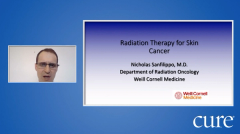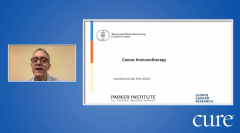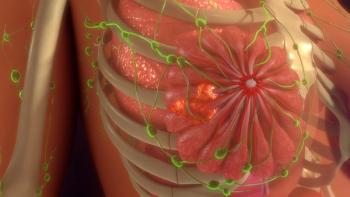
Educated Patient® Skin Cancer Summit Radiation Presentation: June 18, 2022
Watch Dr. Nicholas Sanfilippo, from Weill Cornell Medicine, discuss radiation therapy options during the CURE Educated Patient Skin Cancer Summit.
For some patients with skin cancer, radiation therapy can be an overwhelming process but it is important to know what to expect in terms of treatment and side effects.
Radiation therapy can treat the subtypes of skin cancer in patients who are not eligible for surgery. It may also be used after surgery if the disease has spread to the lymph nodes, explained Dr. Nicholas Sanfilippo, a radiation oncologist at Weill Cornell Medicine in New York City.
“Radiation is a tool; it’s not meant for every tumor. But it’s just like how not every tumor is meant for topical therapy or surgery,” he said during the CURE® Educated Patient ® Skin Cancer Summit.
He added that there are a lot of different ways radiation therapy is done; it could be only one treatment or it could be 20 treatments, depending on the location and size of the tumor. But, on average, the treatment lasts for about two to six weeks.
Sanfilippo said that patients can expect to be in the radiation facility for 45 minutes to an hour, in the treatment room for 15 to 20 minutes, and then the treatment machine is on for only about 60 to 90 seconds.
“Radiation is a bit anxiety provoking, but I think that most patients will find that after the first few days they really settle in,” he noted.
The main side effects from radiation therapy would be on the skin – Sanfilippo compared it to sunburn.The reaction does not happen immediately, it could happen after the first or third treatment, but it is usually noticed after a week of starting treatment and will peak about a week after treatment has ended; it will eventually be gone at around week four to six after treatment has ended.
And in that spot that the skin is reacting to radiation therapy could become a darker color than the rest of the skin, or hyperpigmentation. This side effect can remain for a period of months or even long term; however, it is very subtle.
“I will tell patients that they may always notice something a little different but it’s very unusual for others to notice it because they are subtle changes in the majority of cases,” he added.
Another side effect for patients to be aware of is lymphedema, which is the buildup of fluid in soft body tissues when the lymph system is damaged or blocked, causing swelling to the arms or legs. This usually happens when patients receive treatment with both surgery and radiation therapy. And although it is a delayed side effect, usually happening three to nine months after treatment, it can be permanent. Some things that can help ease this side effect include physical therapy and some compression devices
“I typically tell patients though, particularly after treatment of aggressive disease … that there will be some extent of lymphedema. It’s impossible to avoid, but what we can do is try to mitigate it with those interventions,” he said.
For more news on cancer updates, research and education, don’t forget to

















